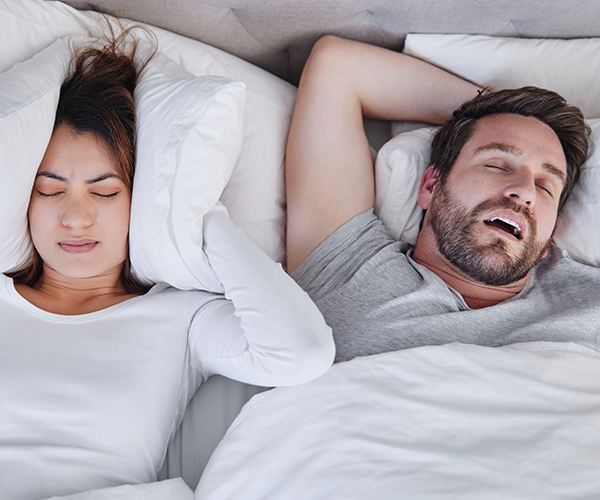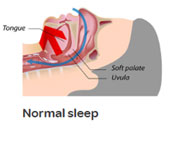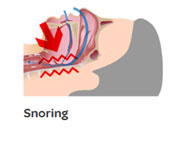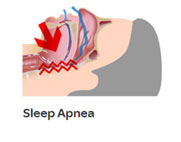Understanding the differences, symptoms, and treatments for better sleep and health.

Many people snore, but not everyone who snores has sleep apnea. While snoring is often seen as a nuisance, sleep apnea is a serious medical condition that can have far-reaching consequences for your health. Understanding the difference between the two can help you overcome sleep issues and take the necessary steps toward the rest you deserve. In this article we’ll discuss the differences between snoring and sleep apnea, symptoms of sleep apnea, types of sleep apnea, and when you should seek professional help.
Snoring — it's the sound that can keep others up at night, but have you ever wondered what actually causes it? Simply put, snoring happens when the airflow through your throat or nasal passages gets partially blocked while you sleep. As air struggles to get through, the tissues in your throat start to vibrate, and that’s what creates the familiar snoring sound we all know (and sometimes dread).Let’s take a closer look at what might be behind your snoring.

Lifestyle choices can have a big impact on snoring.
Snoring isn’t always linked to lifestyle habits; sometimes, it’s due to your body’s structure. Nasal congestion from allergies or a cold can make it harder to breathe through your nose, forcing you to breathe through your mouth and increasing snoring. Physical issues like enlarged tonsils or a deviated septum can block your airway, making it harder for air to flow freely and leading to snoring.No matter the cause, snoring is a sign that your breathing isn’t as smooth as it should be while you sleep. Understanding what’s behind your snoring is the first step in finding a solution.
Sleep apnea is a common but serious sleep disorder where your breathing repeatedly stops and starts during the night. These interruptions can rob your body of the oxygen it needs, leaving you with disrupted sleep and a host of daytime problems.There are two primary types of sleep apnea:
Common symptoms of sleep apnea can include loud snoring, gasping for air or choking during sleep, daytime fatigue — no matter how long you think you’ve slept, and difficulty concentrating or “brain fog.” People with untreated sleep apnea often experience daytime fatigue, morning headaches, and difficulty concentrating, among other symptoms. Over time, the disorder can increase the risk of more serious conditions like heart disease, high blood pressure, and stroke.In summary, here’s an illustration for comparison:



When sleeping normally, your throat is held open by your musclesWhen you snore, your muscles partially relax, resulting in a vibration of your vocal chords, which cause snoringWhen your muscles relax fully, your throat can close completely or partially. This may cause you to snore, gasp for air or even choke
We’ve all had a night of loud snoring, but if it happens often, it might be trying to tell you something more serious. While an occasional snore might just be a harmless sound, it can sometimes be a sign of sleep apnea.So, how can you tell if your snoring is something to worry about? Here are a few signs that it could be sleep apnea, and not just the usual snoring:
Frequent Pauses in Breathing
One of the most noticeable signs of sleep apnea is when breathing repeatedly stops and starts during sleep. These pauses are often followed by gasping or choking as your body struggles to get enough oxygen.
Gasping or Choking Sounds at Night
Waking up gasping for air or hearing choking sounds during sleep isn’t just unsettling — it’s a red flag. These episodes usually happen during deep sleep and are your body’s way of restarting airflow after an obstruction.
Constant Daytime Fatigue
If you’re waking up tired after what seemed like a full night’s rest, sleep apnea could be to blame. Poor-quality sleep can leave you feeling drained, groggy, and more likely to doze off during the day.
Brain Fog and Trouble Focusing
Sleep apnea can prevent you from reaching deep, restorative sleep. Over time, this can affect memory, focus, and concentration — making everyday tasks feel more difficult than they should.
Irregular Snoring Patterns
Snoring that stops and starts — with quiet pauses in between — may point to disrupted breathing. These changes are often one of the earliest signs partners notice and can be a key indicator of sleep apnea.
When it comes to sleep apnea, it's not a one-size-fits-all situation. In fact, there are two main types, each with its own causes and treatments. Let’s break them down.
Imagine you're peacefully drifting off to sleep when, suddenly, your throat muscles relax too much. For a brief moment, your airway becomes blocked. This is what happens with Obstructive Sleep Apnea (OSA), the most common type of sleep apnea. These interruptions can happen hundreds of times during the night, leaving you feeling exhausted in the morning.But don't worry, OSA is treatable! Often, it can be managed with lifestyle changes, and for more serious cases, medical treatments come into play.
Central Sleep Apnea is a bit different. This form occurs when your brain isn’t sending the right signals to your muscles to control your breathing. Unlike OSA, which is physical, central sleep apnea is more about the communication between your brain and your body. It’s less common, but just as serious.If you're dealing with sleep apnea, no matter the type, the good news is there are treatments that can help.
The first line of defense often involves making some lifestyle changes. It’s surprising how a few tweaks to your daily habits can make a huge difference.
But what if lifestyle changes aren’t enough? That’s where medical treatments come in.
It can feel overwhelming to navigate the different treatment options, but the important thing is to find the solution that works best for you. Whether it’s a lifestyle change, a CPAP machine, or a sleep apnea dental appliance, taking the first step toward treatment can vastly improve your quality of life and help you get the restful sleep you deserve.
If you’re dealing with severe symptoms like excessive daytime fatigue or trouble sleeping, don’t wait for things to get worse — take control and seek help from a professional. At Smile Place Dental, we offer oral appliances that help open up the airways while you sleep. These devices also train the muscles to stay in position, allowing you to enjoy restful sleep night after night.Early diagnosis and treatment can significantly improve your quality of life, helping you get the restful sleep you need to feel refreshed and energised.
What’s the difference between snoring and sleep apnea?
Snoring is the sound created by airflow being partially blocked in the throat. Sleep apnea, on the other hand, involves repeated interruptions in breathing throughout the night — a more serious condition that can impact overall health.
How do I know if my snoring might be something more serious?
If you (or a partner) notice pauses in breathing, gasping or choking during sleep, or if you feel unusually tired during the day despite a full night’s rest, it may be time to explore further testing for sleep apnea.
Can sleep apnea be cured?
There’s no one-size-fits-all cure, but sleep apnea can be effectively managed with treatment — whether through CPAP therapy, lifestyle changes, surgery, or dental appliances.
What is CPAP therapy?
CPAP (Continuous Positive Airway Pressure) therapy uses a gentle stream of air delivered through a mask to keep your airways open while you sleep. It’s one of the most common treatments for moderate to severe sleep apnea.
Is sleep apnea dangerous?
Yes. If left untreated, sleep apnea can increase the risk of high blood pressure, heart disease, stroke, and other serious health concerns. That’s why early diagnosis and treatment are important.
How can a dentist help with sleep apnea?
For those with mild to moderate sleep apnea, dentists can create custom oral appliances that reposition the jaw and keep the airway open. These are a non-invasive, comfortable alternative to CPAP for many patients.